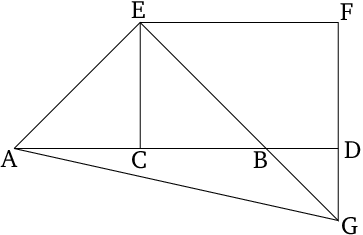If a straight line is cut in half, and any straight line added to it straight-on, then the sum of the square on the whole (straight line) with the (straight line) having been added, and the (square) on the (straight line) having been added, is double the (sum of the square) on half (the straight line), and the square described on the sum of half (the straight line) and (straight line) having been added, as on one (complete straight line).

Algebraically, with \(a:=AD\) and \(b:=BD\), we have \(AC=(a-b)/2\) and \(CD=(a+b)/2\), and the proposition states that
\[a^2+b^2=2\left(\left(\frac{a-b}2\right)^2+\left(\frac{a+b}2\right)^2\right).\]
Proofs: 1